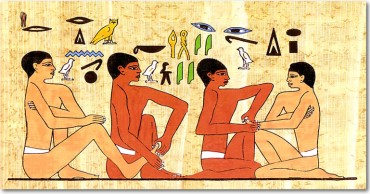« Medicine is the art of imitating the
curative processes of nature » - Hippocrate
Its history
The origins of therapeutic massage go back to time immemorial. Tapping, pressing and rubbing can be observed even among animals, along with fasting and ingestion of medicinal plants. However, in the human realm, these behaviours differ, since conscience participates in the movement. This movement is no longer only instinctive but also thoughtful and methodical. With consciousness, scientific knowledge emerges and supports the discipline. Eventually, massage evolved and progressed as a therapy.
Perhaps the oldest known method, the Ayuredic massage is between 5000 or 6000 years old and is associated with the medicine of the same name. It is rich in mysteries and culture.
In China, massage therapy has also been practiced for a long time. The Tui-na, which used to be known as anmo, dates back some 2700 years B.C. Indeed, the Huangdi Nei Jing, a medical treatise attributed to the famous yellow emperor (2697 to 2597 B.C.), refers to different methods, principally friction techniques used to heal and soothe.
We find foot and palm reflexology in China and Japan going far back into antiquity. Forms of this practice can also be found in ancient tribes in Africa, Australia and America. In Egypt, a fresco has been found depicting therapists massing feet and hands of patients. These frescos, painted more than 2330 years B.C., were found inside Ankhmahor’s tomb, which is also known as the Tomb of Doctors.

The hieroglyphs have been translated as follows: “Do no harm.” The physician replies: “I will make sure that you thank me.”
In the West, we cannot overlook the Greco-Roman civilisation. For the Greeks, passionate for beauty and physical training, massage was part of the popular culture. Following a bath, oil massages were common in gymnasiums and palaestrae. Hippocrates, (460-377 B.C.) a Greek physician, was very influential in the western world until the 18th century and is still known today as the Father of Modern Medicine, is given credit for introducing massage as a proper treatment method. Men of science from these times must be recognized as pioneers in defining the medicinal value of massage.
Massage for the Romans had no therapeutic connotations but was still widely practiced in public spaces (resting rooms, gymnasiums, baths and massage workshops). Unfortunately, these places quickly became places of debauchery, giving massage a bad reputation. This is why the clergy forbade it in medieval times. However, the end of the Renaissance marks the return of massage to the medical profession who had decided to put aside their old prejudices.
More recently, in 1818, we owe a debt to Mr. Pierre Adolphe Piorry for the first modern research on massage. From this time on, the therapeutic discipline closely follows progress in biological and medical science. It can be said that today we prove by observation what was once only known by intuition. Today, past and present knowledge has been brought together allowing us to go further than ever and bringing to light a greater and richer vision of massage therapy. http://en.wikipedia.org/wiki/Massage
The Swedish massage is one of the most widely practiced and better-known types of massage in the west. Doctor Pehr Heinrick Ling (1776-1839), a teacher, a doctor and an athlete, introduced this particular technique to the West. An adventurous person with a passion for fencing, Dr. Ling took off on a journey that lasted seven years. When in Denmark, he met a man named Ming who would soon become his collaborator. Ming, of Chinese origin, was a master in martial arts and the Tui-na traditional massage. Dr.Ling was fascinated by the quality of the physical and philosophical teachings of Ming. His millennial knowledge brought his own knowledge and performances to another level.
In 1804, Ling finally returns to Sweden, bringing with him a new set of skills. Now a teacher, a therapist and a high level athlete, he goes through the whole medical curriculum to scientifically validate his new abilities. His journey leads him to create a series of therapeutic manoeuvres that he calls the standard massage system. Not long after, Doctor Johan Georg Mezger does a synthesis of Dr. Ling’s standard massage system and calls it that the “Swedish” massage system.
In conclusion, we should say that we have only attempted a very rapid overview of the numerous massage techniques available. These techniques have been garnered from incredibly numerous stories bearing witness to the long history of massage therapy. We have to keep in mind that the types of massages we enjoy today are the result of a long series of exchanges between cultures and peoples. These exchanges keep on enriching and adding depth to this wonderful therapy, a therapy that is all natural, accessible, beneficial and, we must not forget, has existed as long as the human race.
